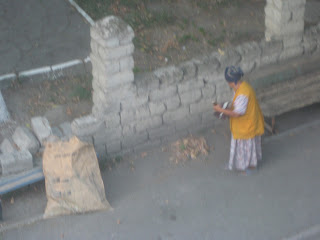Near the stairwell entrance is sheep's wool spread out drying--this is then used to stuff bedrolls, which is what most mattresses are made out of, that people sleep on. Many families keep extra bedrolls handy, so they can roll them out for visiting family members when they come to visit from another part of the country. Most towns and villages do not have hotels or motels for visitors.
In the yard surrounding the apartment building there are occasionally sheep grazing, and always some chickens and roosters, who seem to crow long before sun-up! The chickens roam freely and have even followed me up the stairs to my third floor apartment--I didn't let them in!
Every morning sweeping ladies with twig brooms clean up the area around the apartment building.



Garbage from the apartments is tossed into piles near the apartment buildings. Every day a dump truck comes by, the driver honks his horn to announce he is outside ready to shovel the garbage into the back of his dump truck. However, there seem to be no land-fills, so the most likely disposal place is the river or banks of the near-by reservoir.
My apartment came TOTALLY unfurnished...not even a stool, chair or refrigerator...I was fortunate to be able to furnish it thanks to donations from kind friends, students, teachers and community business leaders. The apartment, circa 1940's had not been updated or remodel in years, and the exposed pipes and exposed, cracked, and deteriorating concrete walls proved to be a bit of a redecorating challenge...hence, some *before* and *after* photos...
With some fabric with the traditional *buta* (paisley) design, I was able to cover up the most obvious flaws, and attaching it and making a back-splash with fabulous duct tape, greatly improved the kitchen appearance.
/But the kitchen floor was so well-worn, I couldn't even hardly clean it, until I painted it with the ubiquitous red floor paint.
Note the ever-common electric red oven. Everyone has one--the gas-stove ovens don't work, or are too dangerous.
On top of my red oven you see the steel water filter, used to strain the boiled water, per Peace Corps health-guidelines...the Peace Corps furnishes us with the water filters.
One of my students, an English teacher from the Teachers' University, gave me her old Russian-built refrigerator...it works basically on and off, and the defrosting is by hand, something I haven't done since the 1960's.
The bathroom *before* picture...followed by the redecorated *after* picture
Because many homes have squat toilets, often those people who do have Western-style sit-down toilets do not use toilet seats, so it took some effort to find a toilet seat. There were some used ones that I could have bought at the bazaar, but I held out for a new one, that I eventually found at a hardware store.
This is the 'kalunka' in the bathroom, a water tank with a coil inside, fed by gas, and which once it is lit, heats up the water in the kalunka in about 15-30 minutes, depending on the gas pressure. The first time I lit it, I experienced a minor (and scary)explosion, and flames shot out across the bathroom, filling me and the room with soot. I soon got the hang of it, however (don't turn the lever on the pipe to the left of the kalunka too much, or too fast).
Because the plaster was totally worn away around the shower exposing molding concrete, I created a new and water proof look with the ever-handy duct tape (thanks to Patrick McGinnis!) The hook to hold the shower head also needed reinforcing with the duct tape, and I made a stable shower head holder by covering some egg-carton with duct tape and attaching strong twine. It works!
It takes some planning to do daily activities that we hardly give a thought to back in the States...for example, if I want to wash clothes and take a shower, it is best to plan to do both on the same day (conserving on heating up the water), but must have enough time in the day to heat up the water and also shower and wash clothes. Hand washing is also an art, I found out, living with a host family. The mom in the host family showed me the quick and easy, as well as 'proper' way to hand wash and wring out the laundry.
I can hang up the laundry on one of my two balconies--one open-air off my bedroom, and one enclosed, typical of most Azerbaijani apartment architecture. However, in winter time, I must move the clothes rack inside, since in the cold it would take days for the clothes to dry outside.
More views of my Peace Corps Palace to follow...






















Wonderful description of your pad. In Kenya we housed the PC Volunteers in local style, but generally nicer mud huts. There was initially just a pit outhouse. Eventually we were able to get a tap into the water pipe and got them a flush toilet and a cold water shower. Those water filters are great. You just have to be careful not to crack the filter elements or they do no good.
ReplyDeleteCheers,
Mike
Thanks for the tip; I will be careful when I clean it, which I should do soon, since there seems to be mud accumulating inside! ...more descriptions to follow, once I upgrade my google Picasa.
ReplyDelete